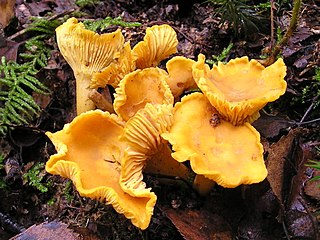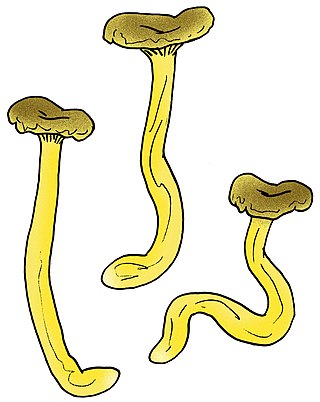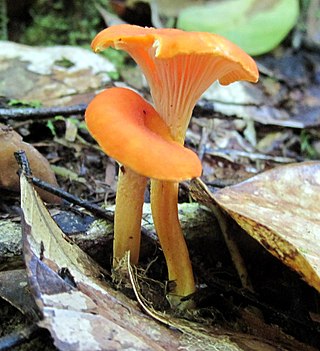
The Cantharellales are an order of fungi in the class Agaricomycetes. The order includes not only the chanterelles (Cantharellaceae), but also some of the tooth fungi (Hydnaceae), clavarioid fungi, and corticioid fungi (Botryobasidiaceae). Species within the order are variously ectomycorrhizal, saprotrophic, associated with orchids, or facultative plant pathogens. Those of economic importance include edible and commercially collected Cantharellus, Craterellus, and Hydnum species as well as crop pathogens in the genera Ceratobasidium and Thanatephorus/Rhizoctonia.

Cantharellus is a genus of mushrooms, commonly known as chanterelles, a name which can also refer to the type species, Cantharellus cibarius. They are mycorrhizal fungi, meaning they form symbiotic associations with plants. Chanterelles may resemble a number of other species, some of which are poisonous.

Polyozellus is a fungal genus in the family Thelephoraceae, a grouping of mushrooms known collectively as the leathery earthfans. Previously considered a monotypic genus, it now contains the Polyozellus multiplex species complex. The genus name is derived from the Greek poly meaning many, and oz, meaning branch. It is commonly known as the blue chanterelle, the clustered blue chanterelle, or, in Alaska, the black chanterelle. The distinctive fruit body of this species comprises blue- to purple-colored clusters of vase- or spoon-shaped caps with veiny wrinkles on the undersurface that run down the length of the stem.

Cantharellus lateritius, commonly known as the smooth chanterelle, is a species of edible fungus in the mushroom family Cantharellaceae. The species has a complex taxonomic history, and has undergone several name changes since its first description by American mycologist Lewis David de Schweinitz in 1822. The fruit bodies of the fungus are brightly colored yellow to orange, and usually highly conspicuous against the soil in which they are found. At maturity, the mushroom resembles a filled funnel with the spore-bearing surface along the sloping outer sides. The texture of the fertile undersurface (hymenium) of the caps is a distinguishing characteristic of the species: unlike the well-known golden chanterelle, the hymenium of C. lateritius is much smoother.

Cantharellus subpruinosus is a species of fungus in the family Cantharellaceae. A European species, it was originally described from France in 2000, where it was found growing in moss in mixed deciduous and spruce woodland.

Cantharellus zangii is a species of fungus in the family Cantharellaceae. Described as new to science in 2012, it is found only in a small area in northwestern Yunnan, China. The fungus produces small, ochre to ochre-yellow fruit bodies (mushrooms) with thin flesh and a long tapering stipe. Microscopically, the mushroom features thin-walled hyphae with clamp connections, and large ellipsoid-shaped spores.

Cuphophyllus cheelii is a species of fungus in the family Cantharellaceae. First described in 1919 by botanists John Burton Cleland and Edwin Cheel, the fungus is found in Australia.

Cantharellus lewisii is a species of fungus in the family Cantharellaceae.

Cantharellus altipes is a species of fungus in the family Cantharellaceae. Described as new to science in 2011, it is found in Texas, where it grows in oak-pine woods.

Cantharellus roseocanus is a species of fungus in the family Cantharellaceae. Found in the Pacific Northwest region of North America, it was originally described in 1997 as a variety of Cantharellus cibarius, and later promoted to distinct species status in 2012.

Cantharellus tabernensis is a species of fungus in the family Cantharellaceae that was described as new to science in 1996. It is found in the southern United States, where it grows in mixed pine and hardwood forests, close to mature Pinus elliottii trees. Fruit bodies have a yellowish-brown cap with a slightly darker brown center, and a bright orange gills and stipe. The specific epithet tabernensis refers to the meeting house at the Stennis Space Center Recreation area, near the type locality.

Afrocantharellus is a subgenus of fungi in the genus Cantharellus. Species in this genus is found in Africa and China.
Cantharellus fistulosus is a species of fungus in the family Cantharellaceae. First described in 2008 as a species of Cantharellus, it was transferred to the new genus Afrocantharellus in 2012.
Cantharellus splendens is a species of fungus in the family Cantharellaceae found in Zambia, Burundi and Tanzania. First described in 1994 as a species of Cantharellus, it was transferred to the new genus Afrocantharellus in 2012.
Cantharellus symoensii is a species of fungus in the family Cantharellaceae. First described by mycologist Paul Heinemann in 1966 as a species of Cantharellus, it was transferred to the new genus Afrocantharellus in 2012.

Cantharellus guyanensis is a tropical South American species of mushroom-forming fungus in the chanterelle genus (Cantharellus), first described by Camille Montagne from French Guiana in 1854.
Pseudocraterellus pseudoclavatus is a species of fungus in the family Cantharellaceae. Smith described it in 1947 as Cantharellus pseudoclavatus, from a collection of a mushroom from the Siskiyou Fork of the Smith River in northern California. He reported it occurred in Washtenaw and Oakland counties in Michigan in oak hickory forest but added that he had mistaken it for G. clavatus as the two were very similar in appearance and hence it could be more widespread. He placed it in the subgenus Gomphus.
Magni is a subgenus of fungi in the genus Cantharellus. Species in this genus is found in China.

Cantharellus ferruginascens is a species of Cantharellus found in Europe.

Cantharellus alborufescens is a species of Cantharellus found in Europe.















